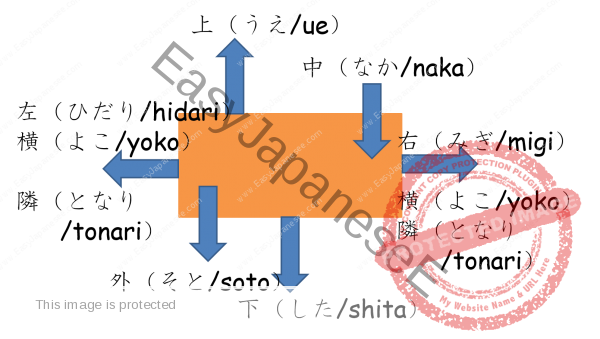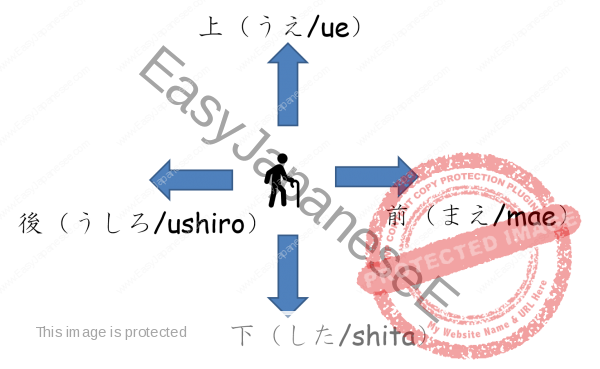In the previous lesson, we talked about います and あります。
Sentence Patterns to describe where things/people are:
[base] の [direction]に [a newly mentioned item] が あります。
[base] の [direction]に [a newly mentioned person/animal] が います。
or
[a known item]は [base] の [direction]に あります。
[a known person/animal]は [base] の [direction]に います。
As you can see above, the verb for non-living, non-moving items is あります and if you are talking about living, moving person/animal, you use います.
Sentence Patterns to describe where an action takes place:
[subject] は [base] の [direction] で [action verb stem]ます。
Direction words


You may find the arrows for なか and そと a bit confusing, but they mean “inside” and “outside” respectively.
Other Direction Words
| そば | nearby, besides |
| ちかく | nearby, close by |
| ひだりがわ | left-hand side |
| へん | around |
| みぎがわ | right-hand side |
Examples
つくえの 上に 本が あります。
There is a book on the table.
その 本は つくえの 上に あります。
The book is on the table.
つくえのなかにお金があります。
There is some money inside the desk.
お金はつくえのなかにあります。
The money is in the desk.
大きな木の 下に ちいさなねこが います。
There is a small cat under the big tree.
わたしの ちいさな ねこは 大きな木の 下に います。
My small cat is under the big tree.
大きな女の子のとなりに小さな男の子がいます。
There is a small boy next to a big girl.
小さな男の子は大きな女の子のとなりにいます。
The small boy is next to a big girl.
ちちは おふろの なかで うたを うたいます。
My father sings in the bath.
ははは スーパーの まえで わたしの せんせいに あいました。
My mum bumped into my teacher in front of a supermarket.
Vocabulary
Living & Moving Subjects (to go with the verb います)
| 男の子 | boy |
| 男の人 | man |
| 女の子 | girl |
| 女の人 | woman |
| おとな | adult, grown-up |
| 子 | a child |
| 人 | a person |
| 男の | male (used like an adjective) |
| 女の | female (used like an adjective) |
| いぬ | dog |
| どうぶつ | animal |
| とり | bird |
| ねこ | cat |
| ペット | pet |
Non-Moving Subjects (to go with the verb あります)
| おかね | money |
| かぎ | a key |
| かさ | umbrella |
| カップ | cup (usually with a handle) |
| かばん | bag (usually with a fixed shape) |
| かびん | (flower) vase |
| かみ | paper |
| カメラ | camera |
| カレンダー | calendar |
| さいふ | wallet |
| ストーブ | a heater |
| ちゃわん | rice bowl, tea cup for tea ceremony |
| テープ | tape |
| テープレコーダー | tape recorder |
| と | door (Japanese style) |
| ドア | door (Western style) |
| トイレ | toilet |
| とけい | watch, clock |
| ナイフ | knife |
| はいざら | ashtray |
| はがき | postcard |
| はし | bridge |
| はな | flower |
| ベッド | bed |
Words that can be used as a base
| いえ | house, family |
| いす | chair |
| いりぐち | entrance, gate |
| うち | home (one’s own) |
| エレベーター | a lift, an elevator |
| かいだん | stairs |
| き | tree, wood |
| きょうしつ | classroom |
| くに | country, hometown |
| クラス | class |
| げんかん | entrance-way, entry hall |
| だいどころ | kitchen |
| つくえ | desk |
| テーブル | table |
| でぐち | exit |
| にわ | backyard, garden |
| はこ | box |
| ふろ | bath |
| へや | room |
| ほんだな | bookshelf |
| まど | window |
| れいぞうこ | fridge, refrigerator |
| ろうか | corridor, hallway |
Prenoun Adjectivals – An adjective used only in front of a noun
| おおきな | big |
| ちいさな | small, little |
Variations
つぎ (next), ~のへん (around ~) and ~がわ (~side) can be used to describe a location.
- いぬの えは つぎの ページに あります。
The dog picture is on the next page. - ゆうびんきょくは この へんに あります。
The post office is around here. - ゆうびんきょくは がっこうの みぎがわに あります。
The post office is on the right side of the school. - がっこうは ゆうびんきょくの ひだりがわに あります。
The school is on the left side of the post office.
Suggested Activities
- Do the exercises in Module 8 of the Moodle Course
- Describing Location Module
